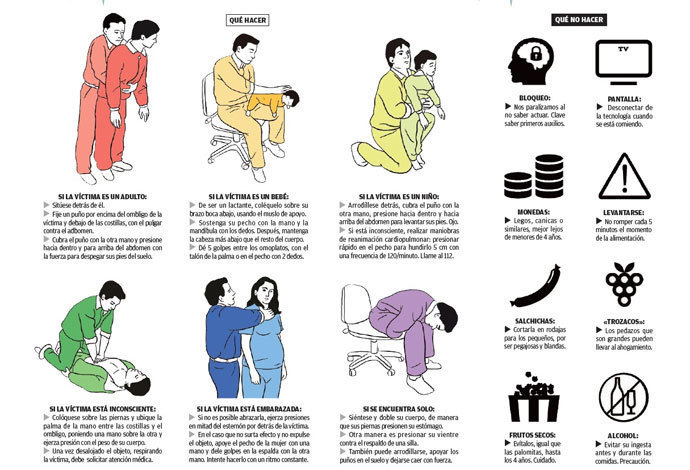
Has your child or someone ever swallowed an object and you didn't know what to do? Whether you have already gone through the experience or not, it is advisable that you begin to educate yourself about first aid techniques and how to perform them correctly.
In a case of choking, every second counts and it is essential to act quickly and safely in what you are doing, while the medical care service arrives at the scene.
Let's delve deeper into this topic.
Choking or choking occurs when someone has a lot of trouble breathing because a food, toy, or other object is blocking the throat or trachea (airway).
The airways of a person who is choking may be blocked so that oxygen does not reach the lungs. Without oxygen, brain damage can occur in as little as 4 to 6 minutes. Prompt administration of first aid for suffocation can save a life.
Abdominal compression or thrusts is an emergency technique to help clear a person's airway.
- The procedure is performed on people who are choking and who are conscious.
- Most experts do not recommend abdominal thrusts for babies under 1 year of age.
- You can also perform the maneuver yourself.
Steps to follow......
- First ask: Are you choking? Can you talk? DO NOT apply first aid if the person is coughing hard and can talk. A strong cough can dislodge the object, if it is difficult to begin the maneuvers, and immediately call 911.
- If the person is choking, perform abdominal thrusts this way:
- If the person is sitting or standing, stand behind them and place your arms around their waist. For a child, you may need to kneel.
- Place your fist, thumb inward, just above the person's belly button. Hold your fist firmly with your other hand.
- Perform quick upward and inward thrusts with your fists.
- If the person is lying on their back, stand above them with one leg on each side. Push your grasped fist up and in in a motion similar to the one above.
- The procedure may have to be repeated several times before the object is dislodged. If repeated attempts fail to open the airway, call your local emergency number 911.
- If the person loses consciousness, begin cardiopulmonary resuscitation.
Clearing maneuvers in babies
- Before performing these resources, You should have called the emergency room . By this time, the child's coughing and breathing are no longer enough.
- Before performing the maneuvers, the severity of the situation, the age and condition of the child must be assessed.
- In the case of an infant, the following procedure must be carried out, which should last less than 10 seconds.
To start...
- The baby is placed face down.
- With one hand hold your cheeks and with your index fingers and thumb keep your mouth open.
- With the heel of the other hand, 5 quick blows should be given with moderate force on the back.
- The child is then placed face up and 5 chest compressions are applied with the index and middle fingers. Due to the fragility of the baby, normal abdominal thrusts should not be performed to avoid rupture of internal organs.
- At the end of the procedure, it is vital to check if he is conscious, his breathing, if he has a cough or if you can observe the object in his mouth to remove it with the extraction maneuver.
Clearing maneuvers in children
- It is essential that parents know how to correctly perform the Heimlich maneuver in order to help their children in case of choking.
- If your child has swallowed an object, but the cough is insufficient, as in the previous case, the following procedure should be followed.
To start...
- Five quick and moderately strong blows should be given to the back.
- Subsequently, due to his condition, it is possible to perform abdominal compressions (Heimlich maneuver).
- To do this, the person performing the maneuver must stand behind the child.
- Then, pass your arms under your armpits and place a fist with the thumb flexed inward in the area between the ribs (epigastrium), above the navel.
- Subsequently, the other hand will be placed on the fist to apply pressure and force the object to change position inside the child.
- In this phase, you should observe if the child coughs, breathes and if it is possible to remove the object from his mouth.
- Otherwise, it is necessary to repeat the maneuver while waiting for the ambulance to arrive.
The best measure is prevention
- Dealing with dangerous situations requires preparation and calm. Although it is important to know rescue procedures if a person has swallowed an object, it is preferable to prevent such accidents.
- To do this, children should be prevented from carrying out any activity with objects in their mouths; or, that they play with small or removable objects or toys.
- As for foods, it is suggested that they be appropriate according to the age of the child. For example, nuts should be avoided until they are 4 or 5 years old.
- Likewise, it is recommended that children and adults be taught to chew slowly and appropriately at mealtime, which includes laughing or talking at the same time.
- Remember, stay calm, induce a cough and call the emergency room immediately.

Share our posts, also like our Facebook, follow us to stay up to date with information like this.





















































